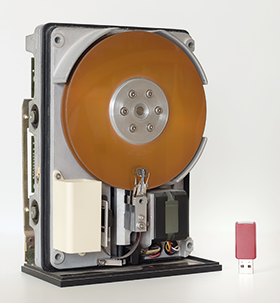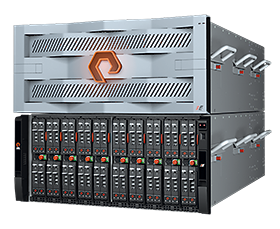

Today there are well known advantages of flash over legacy disk-based storage. However, back in 2009, when the idea for Pure Storage was born, the main barriers to implementing were the purchase cost, the cost of operating it, and working out how to integrate it into the data lifecycle.
Fast forward a few years and flash has become the obvious choice for any performance – or latency – sensitive workload. Since flash memory was introduced to enterprise storage, it has been taking on and replacing hard disk tiers one by one. The market conditions mean that the move to an all-flash data centre has now changed from vision to reality.
There are many reasons why the time for all-flash is today; from dealing with data growth, the cross over between the cost of flash and disk, as well as the clear sustainability savings to be made. The following are some reasons why flash will wipe out the old hard disk for good.
Growth in unstructured data
Running out of capacity or having no additional resources is a nightmare for every IT manager. Getting value and insight from every bit of their data – now that’s nirvana. Unstructured data is expected to grow by 10-fold before 2030, continuing its existing exponential growth. Organisations are going to have to consider how they make use of it all and flash changes the dynamic for big data analytics, data lakes, content repositories, and even backup and recovery.
Cost of NAND
The price-per-bit for NAND flash is declining at a rate much faster than nearline hard drives. While today the cost-per-bit of a hard drive is still lower than the densest flash, there are several key trends to pay attention to in 2023. First, all the major tier one flash manufacturers are demonstrating significant density increases this year, over 200 layers of stacked 3D NAND in some cases. This increase in density will translate into better cost efficiency as well as further improvements in datacentre power and space savings. Second, if analyst predictions hold, NAND prices overall are expected to decline through most of 2023, continuing a trend that began in late 2022.
Flash as an environmental choice
Datacentre infrastructure represents over 1% of global energy consumption, and this share is growing. Organisations are examining their carbon emissions much more closely and many need to look at ways to reduce their carbon footprint. Flash has a vital contribution to this reduction in energy use.
• Unstructured data is complex and power-hungry, and disk is inefficient and space hungry. Put them together and you have mounting issues for data centres, bottom lines, and the environment.
• Power utilisation may not have been a key driver behind moving data sets before, but with rising unpredictability of energy availability, plus an increased focus in reducing emissions, this becomes an investment in the future we can’t afford not to make.
• Because of rising energy costs, energy consumption by information technology has become, not just a concern from an environmental standpoint, but now also a significant economic one.
• Energy efficiency has become a leading factor in enabling flash technology to achieve a lower TCO than disk in the future.
See Pure Storage’s 2021 ESG Report: Technology and Sustainability at www.securitysa.com/*pure1.
Higher performance
For some organisations, cost will trump performance in decision making criteria. In these key ways, the performance advantage of flash over disk can translate into cost benefits.
• First, because disk performance is low, even in workloads with modest performance requirements, organisations often end up with stranded capacity. While spinning drives may hold 20 TB, if the performance of the system taps out at 16 TB, they will not derive as effective a cost-per-bit. Flash doesn’t have this issue because performance stays predictable even as utilisation increases.
• Second, any storage environment needs to deliver on resiliency and will have a redundancy strategy to ensure that data loss is not a risk. With flash devices, faster rebuild times mean less bits need to be dedicated to resiliency structures, which equates to better effective cost efficiency.
• Third, for backup and then recovery following a ransomware incident, disk can take an inordinate amount of restore data. With flash-based systems, faster restore performance means getting your business back online sooner than with legacy disk-based architectures.
• Fourth, going hand in hand with better resiliency is better reliability. Compared to mechanical disk drives, flash is simply more reliable; devices fail less often leading to fewer replacements and therefore lower costs, less time replacing failed components, lower risk and no skyrocketing maintenance costs at years 4, 5, and beyond.
The path to all-flash
Many organisations are already well on the journey to all-flash; they have deployed flash-based storage platforms for their performance sensitive workloads where speed delivers business value. These use cases include databases, private cloud deployments and increasingly, modern analytics environments. Those organisations that have deployed modern all-flash platforms are reaping the benefits of performance, server efficiency, massively simplified operations, as well as energy efficiency and associated greenhouse gas reductions.
Additionally, the ability to consume all-flash for petabyte scale unstructured workloads through a subscription model, allows users to grow as business needs demand. A flexible cloud-like Storage-as-a-Service (STaaS) model should include stringent service level agreements on everything, from administrative support, day-to-day management and energy consumption. This brings even more operational efficiency – further widening the gap to legacy platforms. Migrations can be complex but with the right vendor and partner supporting, it can be painless.
Flash for environmental, workload and cost reasons
The simple truth is that no one today continues to buy spinning drives because they’re better, but only because they’re cheaper. In almost every way, flash memory is superior to spinning magnetic rust, and while flash is already better, these advantages are further increasing. Flash has become a viable option for everyday workloads, offering enterprises a better way to manage data growth efficiently, reliably and sustainably.
Costwise, flash was behind disk, but now the road to the disk/flash crossover point is upon us. Combined with the power, space, and cooling savings, higher performance, and better reliability of flash, this will soon result in hard drives becoming the less cost-effective option. The dream of an all-flash data centre is now a reality for forward looking modern organisations.
Find out more at www.purestorage.com
The FlashBlade//E

Pure Storage has announced the FlashBlade//E, a scale-out unstructured all-flash data repository built to handle exponential data growth with energy efficiency. At an acquisition cost competitive with disk, and much lower operational costs, the introduction of FlashBlade//E means that customers no longer need to settle for disk.
“This launch delivers another innovative technology update to support our customers and enable our partners. In South Africa, customers are looking for solutions which can handle exponential data growth in an efficient way and FlashBlade//E delivers this. Not only that, with energy at a premium and the ongoing concern of electricity availability across South Africa, FlashBlade//E delivers reliability and much better energy efficiency,” says Rupert Brazier, Country Manager, South Africa, Pure Storage.
Unstructured data capacity is expected to grow 10-fold before 2030. For large-capacity, price-sensitive workloads that use current disk-based storage solutions, this growth is unsustainable.
“With FlashBlade//E, we are realising our founder’s original vision of the all-flash data centre. For workloads where flash was once price-prohibitive, we provide customers the major benefits Pure delivers, at a TCO lower than disk,” said Amy Fowler, VP and General Manager, FlashBlade, Pure Storage.
FlashBlade benefits
FlashBlade//E provides a better way to manage unstructured data growth efficiently, reliably, and sustainably with a best-in-class user experience and economics that enable customers to eliminate the last remnants of disk in their data centre:
• Economical at scale: FlashBlade//E is offered at under $0.20 per GB, including three years of service. The platform starts at 4 PB and scales from there with reliable performance.
• Energy efficiency: FlashBlade//E consumes up to five-times less power than the disk-based systems it will replace. The larger the system, the greater the efficiency, helping organisations achieve their increasingly critical sustainability goals.
• Simplicity, reliability, and a non-disruptive future: FlashBlade//E is built to flex and grow on demand with 10-20x more reliability than hard disk-based systems and is evolving without disruption or forklift upgrades. With cloud-like simplicity, flexibility and predictable performance, FlashBlade//E remains simple to manage at any scale.
Find out more at www.purestorage.com

© Technews Publishing (Pty) Ltd. | All Rights Reserved.